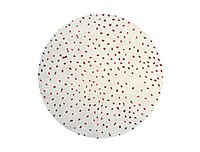
Photo from wikipedia
Brucellosis is a worldwide zoonotic disease and still continuous to be a major public health problem. In this study, it was aimed to identify the Brucella strains to the species… Click to show full abstract
Brucellosis is a worldwide zoonotic disease and still continuous to be a major public health problem. In this study, it was aimed to identify the Brucella strains to the species level isolated from blood cultures, and to determine the rate of antimicrobial susceptibility against eleven antibacterial agents. A total of 106 Brucella spp. strains were included in the study, which were isolated from blood cultures in University of Health Sciences, Konya Training and Research Hospital, Medical Microbiology Laboratory between January 2011 and June 2013. Identification of the isolated strains were mainly based on conventional methods. In vitro antibacterial susceptibilities of azithromycin, ciprofloxacin, doxycycline, gentamicin, levofloxacin, moxifloxacin, rifampicin, streptomycin, tetracycline, tigecycline, and trimethoprim/sulfamethoxazole, were evaluated by using the gradient (E-test, bioMerieux, France) strip method. The bacterial suspensions adjusted to 0.5 McFarland turbidity was inoculated to Mueller Hinton agar plates, supplemented with 5% sheep blood, and E-test strips of selected antibacterial were applied. The plates were incubated in ambient air 48 hours at 37ºC and Escherichia coli ATCC 25922 and Staphylococcus aureus ATCC 29213 were used as quality control strains for antimicrobial susceptibility testing. Minimum inhibitors concentration (MIC) values were interpreted according to Clinical and Laboratory Standards Institute (CLSI) guidelines for slow-growing bacteria such as Haemophilus spp. Of the 106 Brucella spp. strains included in to the study, 90 were identified as Brucella melitensis, and 16 were Brucella abortus. MIC90 values of azithromycin, ciprofloxacin, doxycycline, gentamicin, levofloxacin, moxifloxacin, rifampicin, streptomycin, tetracycline, tigecycline, and trimethoprim/sulfamethoxazole were determined as 1 µg/ml, 0.25 µg/ml, 0.19 µg/ml, 0.25 µg/ml, 0.19 µg/ml, 0.75 µg/ml, 0.25 µg/ml, 0.75 µg/ml, 0.38 µg/ml, 0.64 µg/ml, and 0.19 µg/ml respectively. According to MIC90 values, gentamicin, moxifloxacin, and trimethoprim/sulfamethoxazole, were the most effective antibacterial agents. All the Brucella strains were sensitive to all the tested antibacterial agents except rifampicin. Only six isolates showed intermediate susceptibility to rifampicin. With regard to fluoroquinolones, the most active antibacterial agent was moxifloxacin, followed by ciprofloxacin and levofloxacin. In our study, no resistance was found for the classically recommended antibacterial agents used in the treatment of Brucella species in our hospital but antibiotic susceptibility patterns of Brucella spp. may vary geographically. As a result it was concluded that, the antimicrobial susceptibilities of Brucella species should be determined and controlled periodically to avoid the possible development of resistance problems in the future.
Journal Title: Mikrobiyoloji bulteni
Year Published: 2017
Link to full text (if available)
Share on Social Media: Sign Up to like & get
recommendations!